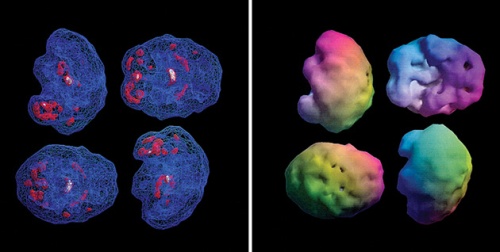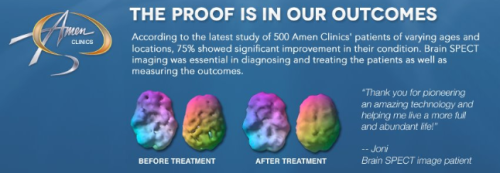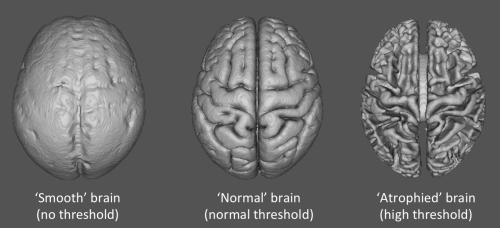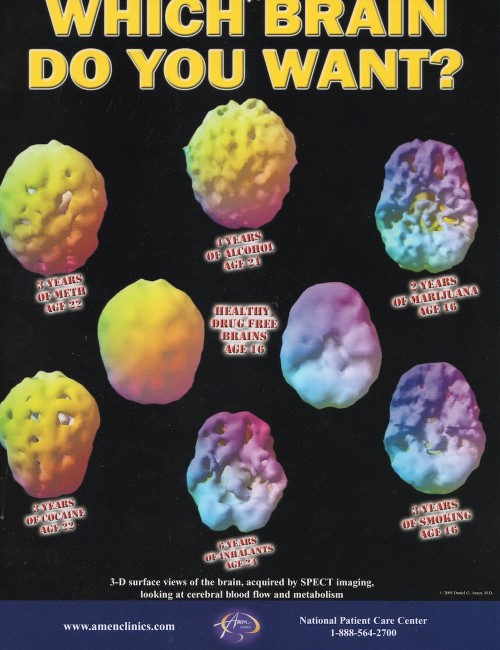I’ve written before about Daniel Amen and his network of Amen Clinics, that (amongst other things) give utterly unnecessary doses of radiation to children. To briefly recap, Amen is a psychiatrist, author, motivational speaker etc. who has built his reputation and fortune on performing brain scans and then wildly exaggerating their diagnostic and prognostic usefulness. His clinics use an imaging modality called SPECT, a largely obsolete technology with terrible spatial resolution that’s been superseded by PET and MRI for most clinical and research purposes. The only real advantage of SPECT is that it’s much, much cheaper to perform than either PET or MRI, which is, of course, precisely why he uses it. He’s been at this a while too. This article in Wired from 2008 contains some choice quotes:
“Let’s look at your scans.” He takes the images that he printed out this morning and puts them side by side on a large table. He points to several views of the surface of my brain. “What I see here is that activity in your prefrontal cortex is low at rest but becomes better when you concentrate, and your thalamus becomes more active, too. I think this means you have a predisposition to depression.”
I nod. Scrutinizing the scans some more, he says, “You need to be busy to be happy. Your brain is cool at rest. You need stuff in your life to feel alive, together, and connected.” He looks at another view, this one showing only the most active regions of my brain. “In this scan, you have increased activity in your thalamus, your two basal ganglia, and your cingulate cortex.” He picks up a pen and draws a line connecting these four regions to the right lateral temporal lobe. “I call this the diamond plus.’ It’s a pattern of angst, and we see it in people who have had significant trauma in their lives.”
And these are the scans that he’s supposedly looking at while making these judgements:
What?! You can’t diagnose conditions like depression in an individual subject from even the very best brain scans, and you certainly can’t see the effects of such nebulous existential concepts like ‘angst’. What the hell is ‘angst’ supposed to mean in this context anyway?! He might as well be saying “The connections between your Shatner’s Bassoon and the peri-sinovial labio-ventral cortex is unusually cromulent and this might predispose you to brilligness, and excessive slithy toveing.” So, yeah, he’s a colossal bullshitter, who must have to keep a fire extinguisher handy at all times to dampen down the constant spontaneous combustion happening in his pants. This is nowhere more true than in the adverts for his clinics. Here’s one from the clinics LinkedIn page:
Brains get significantly less lumpy-looking after treatment – good to know. But hang on – brains are lumpy-looking. They’re covered in ridges and bumps! These smooth-looking pretty-coloured brains that Amen seems to think are great actually resemble lissencephaly; a very serious condition where the developing brain lacks the normal cortical folds. In this case, I’m pretty sure that the smoothness of the images is produced by the fact that the SPECT imaging methods he uses are so poor that they simply can’t show that much detail of the cortical surface. Also, I’ve no idea what the pretty colour-washes are meant to signify, if anything. To show you how easy it is to create images like this, here are some I threw together in about five minutes using FSLView and a standard-space MRI template (the MNI152 1mm template, bundled with FSL), by varying the threshold of the 3D rendered surface:
I’ve written before about why presenting brain images out of context in this way can be extremely misleading. Here’s another choice Amen-sponsored example:
As if it really needed saying; utterly meaningless nonsense. A Google image search brings up loads more examples, but I won’t sully your eyeballs with them unnecessarily. Amen’s use of SPECT images in this way is a gargantuan 20-year effort in energetic turd-polishing of a staggeringly disingenuous and despicable type, and I’m frankly amazed that he still seems to have an active licence to practice medicine.
Many thanks to @CousinAmygdala (and others) who first showed me these kinds of ads, and who also coined the most excellent term ‘neurofearmongering’.






Feminist-inspired neurobollocks from Daniel Amen
Not strictly relevant – I just like it.
I’ve written before about Dr Daniel Amen, the owner of a network of private clinics which perform completely unnecessary brain scans using SPECT (a cheap alternative to PET that involves dosing people with gamma radiation) in order to make spurious diagnoses of everything from ADHD to ‘marital problems’. Unsurprisingly, Dr Amen is also a regular contributor to the Huffington Post; the news source second only to the Daily Fail in its tendency towards rigour-phobic science coverage. A couple of articles he’s posted up there in the last few weeks have caught my eye because of their general dreadfulness, but also because of their particular dreadfulness about women.
The first one is titled ‘Is it time to let women take the wheel?’, in which Dr Amen argues that the world would be a better place if more women were in positions of power and influence. This is a pretty well-worn argument, and intuitively it seems like there might well be some value in it, but Dr Amen claims to have some new evidence:
“the inner CEO (the prefrontal cortex) of women is much more active than men. This area of the brain governs things like judgment, forethought, organization, planning, empathy, impulse control and learning from the mistakes you make. These are the very qualities needed to successfully manage a company, lead a nation, mediate crisis, and get people working together toward a common goal.”
A little bit of a leap there, don’t you think Dr Amen? To my utter shock and amazement the data he’s talking about come from an unpublished analysis of data collected in his clinics.
A couple of weeks later, he’s at it again, jumping on the Lean in bandwagon with another piece: ‘Lean in, and why women’s brains are wired for leadership’:
“women are actually wired for success. The “CEO part of the brain” — the prefrontal cortex, which controls judgment, organization, impulse control, and planning — is more active in women, suggesting that women are wired to hold positions of power and run the world.”
Both these articles are pretty transparent attempts to plug his new book Unleash the power of the female brain. The broad thrust of the articles (that we need more women in positions of influence, and that they have a lot to contribute in such positions) is unarguable, however suggesting women are ‘wired for success’ because of differences in cerebral blood flow is patently ridiculous, and a massive generalisation. Clearly some women make excellent leaders, and some do not (just like men). It’s been known for some time that women’s brains do show somewhat higher blood flow than men’s, however the most likely explanation is that it simply reflects underlying gender differences in Cardiac Index (a body-size normalised measure of cardiac output), which is generally higher in women. In other words, the blood-flow differences in the brain might be a cardiac effect and have very little functional role at all. There is a very interesting discussion to be had about sex differences in brain function and what they might mean, however the differences are generally fairly subtle and nuanced, and the chain of logic connecting them to (group, or population-level) behaviour is insubstantial.
Making bullshit claims about women based on dodgy science and cherry-picked brain data doesn’t advance the feminist cause one little bit. Furthermore, this approach completely ignores the very real and often highly disturbing social challenges that women face on a daily basis. ‘Neurofeminism‘ is apparently a thing now (haven’t read that book, can’t really comment), but these articles make no useful contribution to that discourse whatsoever.
Another irrelevant, picture; just because I really fucking detest Twilight.
7 Comments
Posted in Commentary, Neuroimaging
Tagged brain, Daniel Amen, feminism, Lean in, Prefrontal cortex, Single-Photon Emission Computed Tomography, SPECT